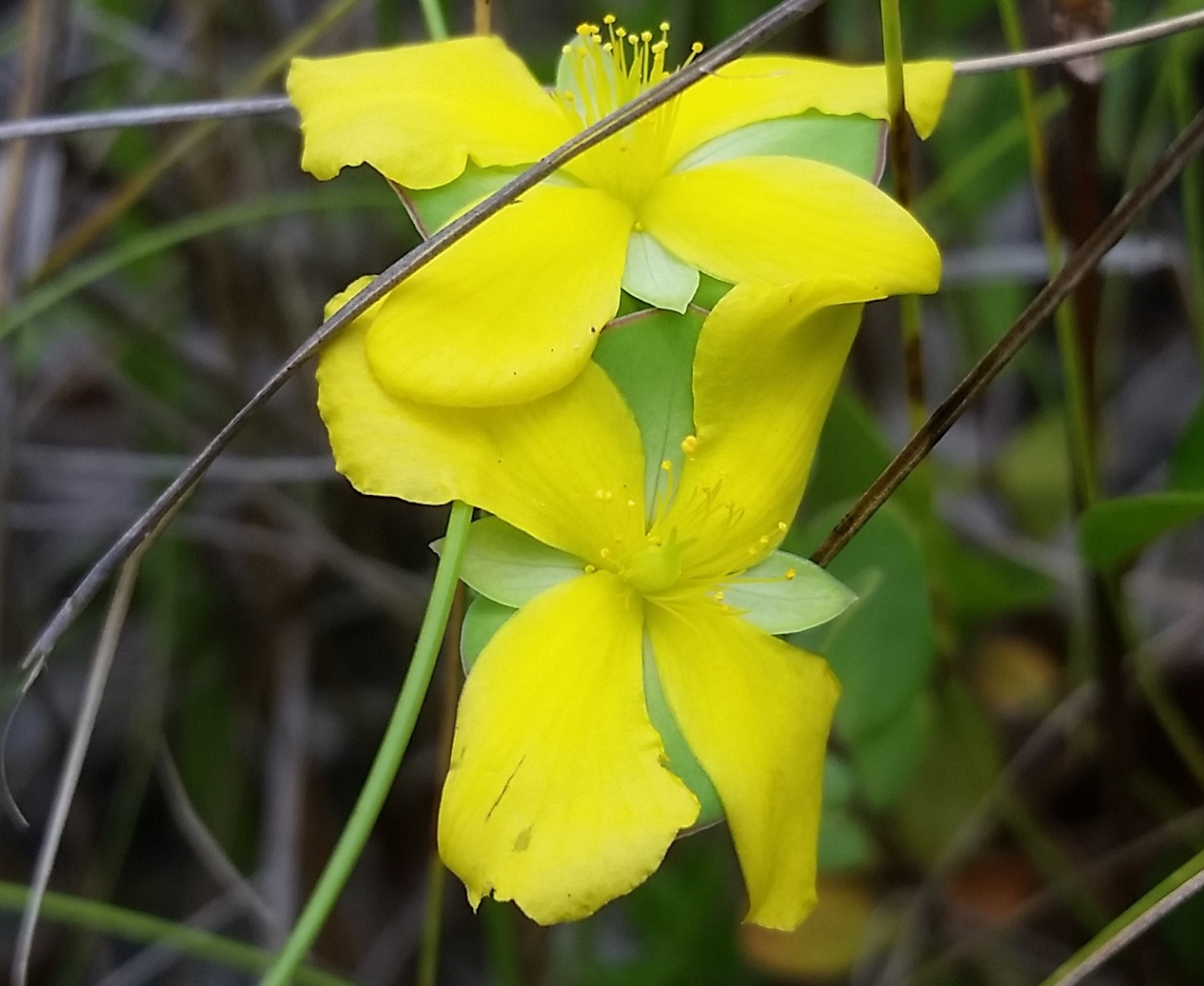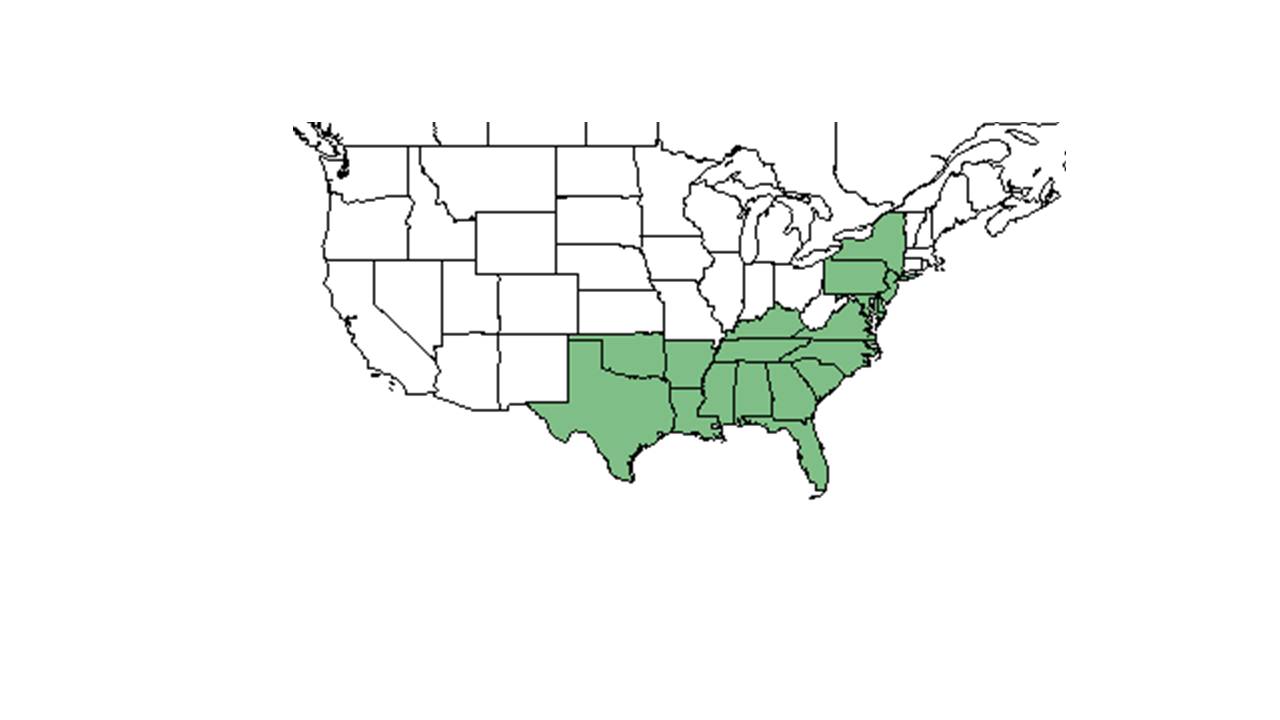Difference between revisions of "Hypericum crux-andreae"
(→Ecology) |
|||
| Line 56: | Line 56: | ||
<!--===Pollination===--> | <!--===Pollination===--> | ||
| − | === | + | ===Pollination and use by animals=== <!--Herbivory, granivory, insect hosting, etc.--> |
| − | It consists of approximately 2-5% of the diet for various large mammals and terrestrial birds.<ref>Miller, J.H., and K.V. Miller. 1999. Forest plants of the southeast and their wildlife uses. Southern Weed Science Society.</ref> | + | ''Hypericum crux-andreae'' has been observed to host ''Panoquina ocola'' (family Hesperiidae).<ref>Discoverlife.org [https://www.discoverlife.org/20/q?search=Bidens+albaDiscoverlife.org|Discoverlife.org]</ref> It consists of approximately 2-5% of the diet for various large mammals and terrestrial birds.<ref>Miller, J.H., and K.V. Miller. 1999. Forest plants of the southeast and their wildlife uses. Southern Weed Science Society.</ref> |
<!--===Diseases and parasites===--> | <!--===Diseases and parasites===--> | ||
Revision as of 14:00, 14 June 2021
| Hypericum crux-andreae | |
|---|---|

| |
| Photo taken by Michelle Smith | |
| Scientific classification | |
| Kingdom: | Plantae |
| Division: | Magnoliophyta - Flowering plants |
| Class: | Magnoliopsida – Dicotyledons |
| Order: | Theales |
| Family: | Clusiaceae ⁄ Guttiferae |
| Genus: | Hypericum |
| Species: | H. crux-andreae |
| Binomial name | |
| Hypericum crux-andreae (L.) Crantz | |

| |
| Natural range of Hypericum crux-andreae from USDA NRCS Plants Database. | |
Common name: St. Peterswort; St. Andrew's cross
Contents
Taxonomic notes
Synonyms: Hypericum stans (Michaux ex Willdenow) W.P. Adams & Robson; Ascyrum stans Michaux ex Willdenow; Ascyrum cuneifolium Chapman.[1]
Varieties: none.[1]
Description
Hypericum crux-andreae is a perennial shrub or subshrub in the Clusiaceae family.
“Usually glabrous herbs or shrubs. Leaves usually punctate, simple, opposite, entire, usually sessile or subsessile, exstipulate. Inflorescence basically cymose; flowers perfect, regular, bracteates, subsessile or short-pedicellate, sepals 2, 4, or 5, persistent; petals 4 or 5, usually marcescent, yellow or pink; stamens 5-numerous, separate or connate basally forming 3-5 clusters or fascicles, filaments usually persistent; carpels 2-5, stigmas and styles separate or fused, ovary superior, 1-locular or partly or wholly 2-5 locular, placentation axile or parietal. Capsules basically ovoid, longitudinally dehiscent, styles usually persistent; seeds numerous, lustrous, areolate, cylindric or oblong. In general our species form a polymorphic complex with many intergrading taxa.[2]
"Erect shrub, 4-10 dm tall with shreddy old bark. Leaves coriaceous, elliptic, ovate, or obovate, 1-4 cm long, 5-20 mm wide, obtuse, slightly revolute, base widely cuneate, rounded, or slightly clasping, notched. Flowers solitary, axillary, or in cymules; bracts paired, near center of pedicel to near base of calyx; pedicels 4-10 mm long. Outer sepals cordate or ovate, 6-7 nerved, 10-18 mm long, 8-15 mm wide, acute or obtuse, inner sepals lanceolate, 6-15 mm long, 203 mm wide, acute to acuminate; petals 4, 10-18 mm long; styles usually 3(2-4), separate, 1-2.5 mm long, ovary 1-locular. Capsules ovoid, 7-10 mm long, 4-5 mm broad; seeds brown, 0.7-0.8 mm long."[2]
Distribution
This species is distributed from New York in Long Island and New Jersey south to southern Florida and west to eastern Texas. It is mostly along the Coastal Plain, but is also scattered more inland to western North Carolina and northern Georgia as well as up to central Tennessee, southern Kentucky, central Arkansas, and southeastern Oklahoma.[3]
Ecology
Habitat
Hypericum crux-andreae is generally in pine savannas, pine flatwoods, seeps and bogs, and mesic to dryish woodlands and forests.[3] This species mostly does well in various sandy sites and pine barrens.[4] It is found in longleaf pine-wiregrass flatwoods[5] and titi-cypress swamp communities in Florida.[6] It can also occur in some disturbed habitat like fallow fields.[7]
Associated species include Andropogon, Pinus palutris, Aristida stricta, Cyrilla racemiflora, Salix humilis, Cephalanthus occidentalis, Saccharum sp., Dichanthelium scoparium, Smilax rotundifolia, Proserpinaca pectinata, and Hypericum brachyphyllum.[7]
Hypericum crux-andreae is frequent and abundant in the Upper Panhandle Savannas community type as described in Carr et al. (2010).[8]
Phenology
Generally, H. crux-andreae flowers from June until October.[3] It has been observed flowering in February, March, May through November, and fruiting has been observed in October.[7][9]
Seed dispersal
This species is thought to be dispersed by gravity. [10]
Seed bank and germination
Several short-lived perennial forbs also have a seed bank persistent for at least several years.[11] It has also been found in the seed bank of a disturbed longleaf pine site.[12]
Fire ecology
This species has been found in habitat that burns frequently.[7] However, it has been seen to benefit most from low fire return intervals.[13]
Pollination and use by animals
Hypericum crux-andreae has been observed to host Panoquina ocola (family Hesperiidae).[14] It consists of approximately 2-5% of the diet for various large mammals and terrestrial birds.[15]
Conservation, cultivation, and restoration
It is listed as threatened by the Kentucky State Nature Preserves Commission, and is listed as extirpated by the Pennsylvania Department of Conservation and Natural Resources.[16]
Cultural use
Photo Gallery
References and notes
- ↑ 1.0 1.1 Weakley, A.S. 2015. Flora of the southern and mid-atlantic states. Working Draft of 21 May 2015. University of North Carolina at Chapel Hill, Chapel Hill, North Carolina.
- ↑ 2.0 2.1 Radford, Albert E., Harry E. Ahles, and C. Ritchie Bell. Manual of the Vascular Flora of the Carolinas. 1964, 1968. The University of North Carolina Press. 709-711. Print.
- ↑ 3.0 3.1 3.2 Weakley, A. S. (2015). Flora of the Southern and Mid-Atlantic States. Chapel Hill, NC, University of North Carolina Herbarium.
- ↑ [[1]] Lady Bird Johnson Wildflower Center. Accessed: May 23, 2019
- ↑ Brockway, D. G. and C. E. Lewis (1997). "Long-term effects of dormant-season prescribed fire on plant community diversity, structure and productivity in a longleaf pine wiregrass ecosystem." Forest Ecology and Management 96: 167-183.
- ↑ Drewa, P., W. Platt, et al. (2002). "Community Structure along Elevation Gradients in Headwater Regions of Longleaf Pine Savannas." Plant Ecology 160(1): 61-78.
- ↑ 7.0 7.1 7.2 7.3 Florida State University Robert K. Godfrey Herbarium database. URL: http://herbarium.bio.fsu.edu. Last accessed: June 2014. Collectors: Loran C. Anderson, Wilson Baker, Andre F. Clewell, M. Davis, R. F. Doren, Robert K. Godfrey, Ann F. Johnson, J. M. Kane, R. A. Norris, and Cecil R. Slaughter. States and Counties: Florida: Duval, Franklin, Jackson, Leon, Liberty, and Wakulla. Georgia: Baker, Grady, and Thomas. Texas: Hardin.
- ↑ Carr, S.C., K.M. Robertson, and R.K. Peet. 2010. A vegetation classification of fire-dependent pinelands of Florida. Castanea 75:153-189.
- ↑ Nelson, G. PanFlora: Plant data for the eastern United States with emphasis on the Southeastern Coastal Plains, Florida, and the Florida Panhandle. www.gilnelson.com/PanFlora/ Accessed: 12 DEC 2016
- ↑ Kirkman, L. Katherine. Unpublished database of seed dispersal mode of plants found in Coastal Plain longleaf pine-grasslands of the Jones Ecological Research Center, Georgia.
- ↑ Platt, W. J., S. M. Carr, et al. (2006). "Pine savanna overstorey influences on ground-cover biodiversity." Applied Vegetation Science 9: 37-50.
- ↑ Cohen, S., et al. (2004). "Seed bank viability in disturbed longleaf pine sites." Restoration Ecology 12: 503-515.
- ↑ Mehlman, D. W. (1992). "Effects of fire on plant community composition of North Florida second growth pineland." Bulletin of the Torrey Botanical Club 119(4): 376-383.
- ↑ Discoverlife.org [2]
- ↑ Miller, J.H., and K.V. Miller. 1999. Forest plants of the southeast and their wildlife uses. Southern Weed Science Society.
- ↑ USDA, NRCS. (2016). The PLANTS Database (http://plants.usda.gov, 23 May 2019). National Plant Data Team, Greensboro, NC 27401-4901 USA.